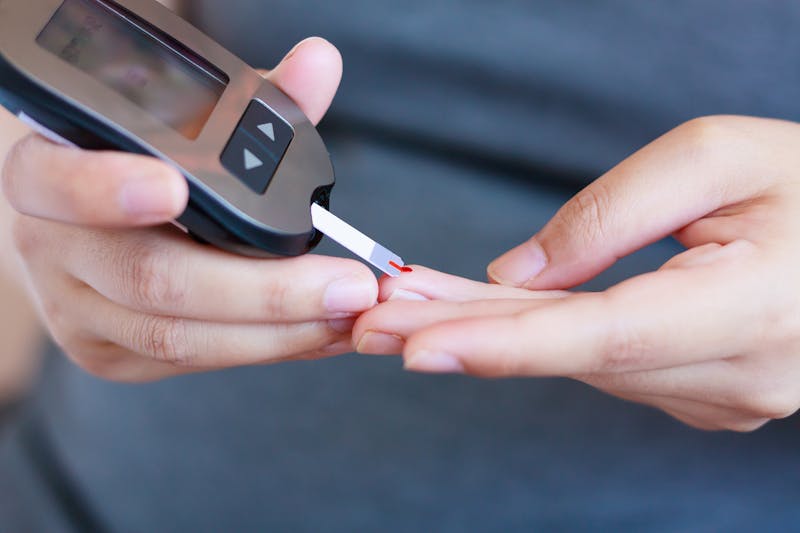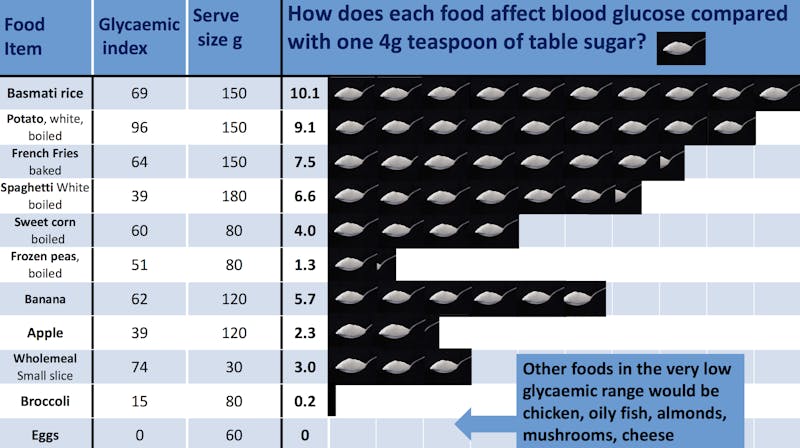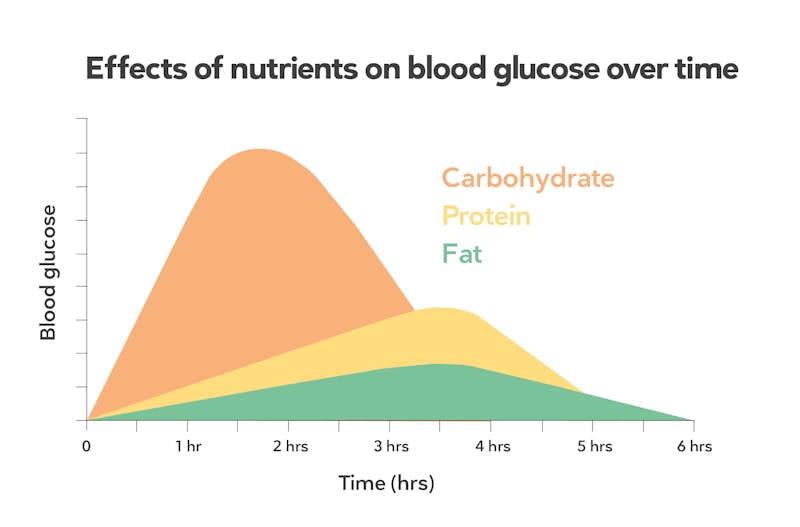Is 91 High for a Sugar Reading
What you need to know about claret carbohydrate
- Getting started
- Normal blood saccharide
- Low claret saccharide
- Loftier claret sugar
- Diet and blood sugar
- Other means to measure
- Depression carb and blood sugar
Maybe you bought a blood saccharide meter because you've been given a concerning diagnosis of pre-diabetes or diabetes. Or possibly one of these weather condition runs in your family. Perhaps you're just curious to know what nutrient does to your claret sugar — and willing to cede a few drops of blood to find out.
If you're new to testing your blood sugar, rest assured that it's unproblematic to do.
Whether you're experienced at it or non, testing your blood sugar can help yous better identify which dietary changes lower your blood saccharide over time. It can also assist you identify specific foods that raise claret sugar.
Disclaimer: This guide is meant to assist you understand the basics of checking blood glucose. It is not meant as medical advice. Low blood sugar tin can potentially exist a life threatening condition. If you lot accept low blood saccharide and have symptoms every bit described in this guide, the quickest solution is to eat or potable sugar or carbs, and so consult with your physician regarding the adjacent step
i. Getting started
Many different blood sugar meters (as well known as glucose meters or glucometers) are available, and most of them are fairly inexpensive.
All the same, make sure that the test strips for your meter are affordable and available. The real cost of blood-sugar testing lies in the cost of the strips, which tin only exist used in one case and expire after a sure engagement.
In addition to a meter and strips, yous'll demand a lancet, which contains a short, minor needle that will prick your finger quickly and (most) painlessly. Lancets are very cheap and are discarded after each use. Most blood sugar meters come with a lancet and about a dozen replacement needles.
How to measure blood saccharide
You lot should read the directions that come with your blood sugar meter and follow those carefully. For most meters, the general procedure goes like this:
- With clean easily, place a test strip in your blood carbohydrate meter.
- Prick the side of a finger with the lancet to depict a drop of blood.
- Identify the tip of the test strip on the drop of blood.
- Afterward a few seconds, the blood sugar meter will give you lot a reading.
Many blood sugar meters volition keep track of your claret carbohydrate readings for a number of days or weeks. Even if your meter stores these readings, it may be a good idea to record the appointment, time, and other information to share with your healthcare provider or for your own purposes. Use a notebook, figurer spreadsheet programme, or app to keep track of your readings.
When to measure blood carbohydrate
If your healthcare provider has given you lot specific instructions about when to exam your claret carbohydrate, you should follow those instructions.
Many people cheque their blood sugar first thing in the morning, before eating. Considering no nutrient has been consumed for at least viii-10 hours, a blood sugar measurement at this time of mean solar day is called a "fasting blood sugar." Information technology'southward all-time to bank check this at the aforementioned fourth dimension every 24-hour interval.
You can also cheque your blood sugar right earlier eating (a pre-meal or preprandial level) or later a meal (a post-meal or postprandial level). If you've been instructed to check your blood sugars at a specific time interval after a meal, you lot should begin timing once you start eating.one

two. What is a normal blood carbohydrate?
Ideas nearly "normal" claret carbohydrate levels are based on individuals eating a standard American nutrition. This type of diet usually contains most 50% of calories from saccharide, the nutrient that tends to enhance claret saccharide the most.2
If your own carbohydrate intake is much lower than this, you may have a different "normal." You can jump to How a depression-carb nutrition affects claret carbohydrate measurements for more information.
Fasting claret saccharide levels
A normal fasting claret carbohydrate level in someone who does not have diabetes is generally betwixt seventy and 100 mg/dL (3.9 to 5.vi mmol/L).3
Fasting blood sugar that consistently falls in the range of 100 to 125 mg/dL (5.6 to 6.9 mmol/L) is considered prediabetes, which is also referred to as impaired fasting glucose.
If your fasting blood sugar is higher up 126 mg/dL (7.0 mmol/l) on 2 separate occasions, so yous may have diabetes.
If you are concerned well-nigh the measurements you're getting, particularly if y'all are already on a low-sugar diet, run into How a depression-carb nutrition affects blood sugar measurements. A few blood sugar measurements may non always provide an accurate picture of your wellness.
Post-repast blood saccharide levels
If your healthcare provider has non given you lot specific instructions regarding when to test mail-meal claret sugar, you may want to try measuring it one to two hours afterwards you begin eating. Whichever reading is the highest is the i that you should pay attention to, because blood sugar levels may top at dissimilar times.
How much and how chop-chop your blood sugar level increases later eating is mainly determined by your trunk's ability to handle carbohydrates.4
In people who don't have diabetes, blood sugar levels typically peak about an hour afterward starting a repast.5 Notwithstanding, in people with type 2 diabetes, claret carbohydrate typically peaks virtually two hours after starting a meal.6 For this reason, people with diabetes are unremarkably advised to measure their blood sugar two hours after eating.
According to the American Diabetes Association, a normal post-repast blood sugar reading 1 or ii hours after a repast is below 140 mg/dL (vii.eight mmol/50).7 Some clinicians and individuals who are more cautious about high blood sugar may adopt using a carb-restricted arroyo targeting a post-meal claret sugar level of 120 mg/dl (6.seven mmol/50) or lower.8
If your blood sugar is consistently 140 mg/dL (7.8 mmol/L) or higher but less than 200 mg/dL (eleven.1 mmol/L) when measured 2 hours after kickoff a meal, you may have prediabetes or impaired glucose tolerance.9
If your blood sugar measurements are consistently 200 mg/dL (11.one mmol/L) or higher two hours after first a meal, you likely have diabetes.10
If your fasting or post-meal blood sugar levels are consistently college or lower than normal, yous may have a medical condition that requires a visit to a healthcare provider.
However, if your claret sugar levels suddenly go from "normal" to "not normal" when you get a new meter or a new container of test strips, check your meter and strips to ensure they're taking authentic measurements. When a event is very dissimilar than expected, take three measurements and use the boilerplate of the three.11
Blood glucose chart
Each measure should be done on at least 2 split up occasions before you doubtable that your claret sugars are also high or also low. Meet your healthcare provider almost any concerns yous may accept about your blood sugar readings
three. What to do if your blood sugar levels are lower than normal
Claret sugar levels that are below 70 mg/dL (iii.9 mmol/L) are known every bit hypoglycemia. Symptoms of hypoglycemia include middle palpitations and feeling lightheaded, jittery, irritable, fatigued, or sweaty.12
Low fasting blood saccharide levels tin occur if you have diabetes and your medication does not lucifer your carbohydrate intake. And so it's very of import to allow your healthcare provider know you're post-obit a depression-carb nutrition so they tin adjust your medication to match your carb intake.
In people who do not have diabetes, low fasting claret sugar levels are very rare. But if low blood sugars do occur they may be the result of a serious underlying medical condition such every bit an eating disorder or a tumor. If your fasting claret saccharide is low and you lot practice not take diabetes medications, come across your healthcare provider.
Low claret sugar levels later eating are oftentimes called reactive hypoglycemia. This tin can occur in people with diabetes, as well as those with normal fasting blood sugars. How information technology should be treated depends on what the underlying cause is. Merely if you take depression blood sugar and experience symptoms, you can remedy this in the short term by eating something with carbs or sugar.13
High-carb intake may cause reactive hypoglycemia in people who are very insulin sensitive or have experienced massive weight loss.fourteen A low-carb, high-poly peptide nutrition has been establish to improve reactive hypoglycemia in adults who have undergone weight-loss surgery.15
four. What to do if your blood sugar levels are higher than normal
If your fasting or post-meal blood sugar readings are consistently higher than normal, you may accept prediabetes or diabetes. If you suspect you take diabetes or prediabetes, you should run into your healthcare provider equally soon as possible.
Symptoms of diabetes, beyond elevated blood sugars, may include increased thirst and urination, severe fatigue and excessive hunger. For more details, run into our guide to common signs and symptoms of diabetes.

5. Personalizing your nutrition based on claret sugar response
In addition to seeing your healthcare provider, there are steps you can take to reduce your blood carbohydrate levels. If you check your blood sugar after meals and continue track of those measurements, along with the types and amounts of food you ate, you may exist able to see which foods are problematic.
Although an increase in blood sugar is usually due to eating high-carb foods, all carbs are not the same when it comes to raising blood sugar. Considering starchy foods digest down to glucose (saccharide) very apace, some starchy foods may end upward having a much greater touch on on claret sugar than you might look.
For instance, even though a banana tastes sweeter than a baked potato, the potato may actually have a bigger impact on blood sugar.16
Considering high-carb foods have the biggest impact on blood saccharide levels, it makes sense to reduce them, no matter what type of diet you follow. The American Diabetes Clan made this bespeak in a 2019 paper on nutrition for people with diabetes.17
Sometimes making gradual changes can work all-time. Our guide, Eating ameliorate: six steps downwardly carb mountain, can help y'all lower your carb intake, one stride at a time.
If yous've been diagnosed with type one or type 2 diabetes, our guide to the best foods for people with diabetes tin assist you make choices that may reduce your need for blood carbohydrate control medications.
Other foods that are low in carbs may besides increase blood saccharide response. For example, in ane study when caffeinated java was consumed with meals containing either apace digested or slowly digested carbs, blood sugar levels were college than they were after the aforementioned meals without caffeine.18
If a food or beverage seems to be causing your claret sugar to ascent too much, try leaving it out of your diet for a few days to see if you notice a difference.

6. Other ways to measure out blood sugar
Checking your claret saccharide levels with a glucometer is not the just fashion to mensurate blood saccharide. Other tests that your healthcare provider might utilize to cheque your blood saccharide levels are hemoglobin A1c (HbA1c) and oral glucose tolerance examination (OGTT). Peradventure the most helpful data comes from a continuous glucose monitor (CGM). You can learn more about CGMs in our evidence-based guide.
HbA1c provides an estimate of your average blood sugar levels over fourth dimension, giving you a sense of your blood sugar control over the last ii or 3 months. An HbA1c test is one of the near common measurements used for diagnosing type ii diabetes.19
Withal, HbA1c tests and blood sugar tests don't always agree. Using HbA1c levels to diagnose diabetes often fails to identify individuals who would otherwise be diagnosed with diabetes using blood saccharide levels.20
Your HbA1c is normal if it is below five.7%. You may have prediabetes if your HbA1c is higher up 5.7% only less than 6.five%. Y'all may accept diabetes is your HbA1c is 6.five% or over.21
| HbA1c | |
| Normal | less than 5.vii% (38.8 mmol/mol) |
| Prediabetes | 5.7% to half dozen.4% (38.8 to 46.4 mmol/mol) |
| Diabetes | 6.5% (47.v mmol/mol) or higher |
| "Cautious" approach | Less than 5.4 % (36.0 mmol/mol) |
To larn more than most HbA1c measurements and how they relate to blood sugar levels y'all tape with your glucometer, come across our total guide to agreement HbA1c.
An oral glucose tolerance exam (sometimes referred to equally an OGTT) tin be more accurate in terms of diagnosing prediabetes or diabetes.22 Information technology measures your blood sugar two hours afterward y'all drink 75 grams of glucose. Because it requires drinking a large carbohydrate solution, an OGTT may not be a useful test for someone on a long-term low-carb or ketogenic diet (more on this in the side by side section).
A continuous glucose monitor (CGM) is a vesture device that, as the name says, continuously measures claret glucose levels. Although they may be more expensive than glucometers and more than challenging to get covered by insurance, they're a helpful way to measure blood sugar throughout the day. CGMs allow you to easily come across mail service-meal variations and get an average claret sugar level for the twenty-four hours.
vii. How a depression-carb diet affects blood sugar measurements
If y'all are on a depression-carb diet, you may find that some ways of measuring blood carbohydrate will non provide you with "normal" levels.
For example, fasting claret carbohydrate levels may be slightly above normal. This may exist due to "adaptive glucose sparing" and "the dawn miracle."23Your fasting blood sugar levels may be elevated because your liver is making actress glucose to gear up your trunk for the 24-hour interval.
If you are concerned almost these levels, consider asking your healthcare provider for a more detailed evaluation including an HbA1c or CGM.
If you're on a low-carb diet, your HbA1c will likely be lower than your fasting blood sugar levels would predict, since your blood sugar probably doesn't increase much after meals.
For people who have been on a depression-carb diet for a long fourth dimension, an OGTT may mistakenly diagnose you as having diabetes. Considering your body is fatty adapted and no longer using sugar every bit its chief fuel, you may have an exaggerated blood sugar response to the glucose drinkable. If that occurs, you may fail the test and be given a diabetes diagnosis when you really do not have the status.24
If your doctor orders an OGTT test and you want to have it, you may want to starting time consuming more than carbs most three days earlier the test.
Conversely, if y'all are on a ketogenic diet and take elevated ketones, your blood sugar may naturally be seventy mg/dL (three.9 mmol/50)or slightly beneath. In this instance, because ketones are fueling your body, you likely won't have typical symptoms of hypoglycemia, such as shakiness or lightheadedness.25
Checking claret sugar can exist a simple way to learn the effects various foods have on your body. However, it's of import to recall that your blood sugar level, similar your weight, is just a number. Panicking when your fasting blood sugar is 102 mg/dL (5.7 mmol/L) ane morning adds actress stress to your day, which isn't beneficial to your health!
Use your glucometer wisely, as some other tool in your toolbox on your wellness journeying.
/ Adele Hite, PhD MPH RD
Source: https://www.dietdoctor.com/blood-sugar